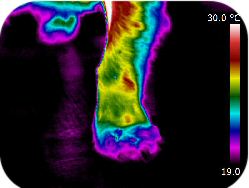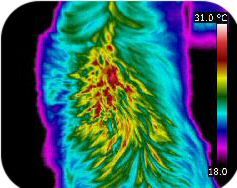Veterinary Thermal Imaging
|
|
|
|
Its application in Agility dogs...
|
|
Joint injuries Figure 1- shows inflammation surrounding the carpal region. |
 |
|
Back pain Figure 2 – Shows an increase in temperature over the Latissimus Dorsi muscle, which may indicate muscle spasms. |
 |
|
Foot and toe injuries Agility dogs are prone to foot and toe injuries. Slats on touch point equipment can result in deformation of the foot's structure, which can worsen when braking is applied at the same time. For instance, running down an A-Frame could result in injuries such as toe injuries (torn off toe nail, dislocation, sprained or broken toes), fractured sesamoid bones, arthritis (Carpal region) and even tendon injuries. |
 |
|
Nerve dysfunction Dogs that partake in agility are at a higher risk for developing injuries such as intervertebral disc degeneration due to the repetitive flexion and extension of the spine over the various agility apparatus. Injury to nerves will be naturally cooler than injuries which involve inflammation such as tendon injuries. This is due to the increased tone in the nerves (pressure), and results in increased sympathetic tone, which produces cooling in the corresponding areas under control of different nerves.
Very discrete borders are seen to the different areas of colour within the canine
thermograph. These areas of colour are called dermatomes. Dermatome maps have been
produced to identify the correlating nerve that is affected. |
 |
|
Other injuries |
Thermal imaging has many advantages for the agility dog.
One of its main advantages is that recent
research has shown thermography can identify areas of injury in some cases three weeks before
clinical symptoms are exhibited. This allows a quicker treatment and recovery period, allowing
the dog to return to its agility training sooner. At the same time, it can also help in
preventing or pinpointing secondary issues. Thermal imaging is non–invasive which means the dog
can be reimaged as often as required to track its recovery period without the need for
anaesthetics or sedation.
Veterinary Thermal Imaging Ltd prices are reasonably inexpensive with imaging starting from £40 plus call out.
 To find about more about Veterinary
Thermal Imaging, see
www.veterinary-thermal-imaging.com
Alternatively email
enquiries@vtiuk.com
or ring 0800 408 3891.
To find about more about Veterinary
Thermal Imaging, see
www.veterinary-thermal-imaging.com
Alternatively email
enquiries@vtiuk.com
or ring 0800 408 3891.
About the author...
Stephanie Godfrey is a Veterinary Thermographer.
She is involved with gundog training and trailing,
First published 28 January 2013
|
[bottom.htm] © Copyright Agilitynet |